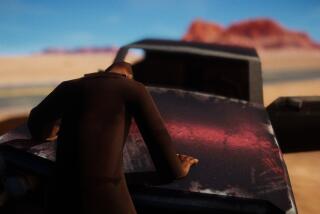‘Max Payne’ a Matrix of Noir Violence
- Share via
A young New York cop on the rise comes home to find his family slaughtered by druggies. Then he’s framed for his partner’s murder.
And that’s just the beginning of “Max Payne,” as players guide the cop through a noir nightmare of thuggery and brutishness. It’s a PC game that plays like an interactive comic book, complete with graphic interludes that describe Payne’s bloody descent into the New York underworld.
“Max Payne” borrows as freely from comic book master Frank Miller as it does from “The Matrix” directors Andy and Larry Wachowski. Oddly, though, it rips off relatively little from other video games.
Yes, it’s a third-person action-shooter that stands on the technical shoulders of giants such as, well, “Giants: Citizen Kabuto” and “Messiah.” (Finally, third-person games have begun to get the hang of character control and perspective.) And it snags some of the visual grittiness of “Kingpin.” Overall, though, “Max Payne” offers a fresh way to play and reinvigorates a genre that all too often hovers just above stagnation.
For instance, a key feature of the game is the ability to switch into “bullet time.” Think of the scene in “The Matrix” in which Neo dodges a hail of bullets by contorting faster than the slugs can reach him. That’s what happens in “Max Payne.”
In true one-man-against-the-world form, bad guys swarm Payne when he gets near. In real-time shooting, taking down all these thugs--even with a sawed-off shotgun--would be something close to impossible. “Max Payne” allows players to briefly slow down the action while aiming in real time.
The result: The ability to dive behind boxes or other obstacles without losing the kind of sharp aim necessary to double-tap nasties. In many sequences, “bullet time” becomes an absolute necessity and players will wonder how they lived without it for so long.
Although such a feature might seem to make the game easier, another element in “Max Payne” compensates for it. Bullets in “Max Payne” actually take time to travel from guns to targets. It doesn’t sound like a big deal, but it is.
Aiming at a bad guy’s forehead does not necessarily mean that’s where the bullet will hit. If, for instance, he continues to run, the fraction of a second might give him the opportunity to get out of the way. The bullet might just graze his shoulder--or miss completely.
That degree of realism infuses “Max Payne” with a sense of freshness sadly missing from most games in the genre. Plus, the control system beats almost every other third-person title available.
Stepping into Max Payne’s dark, violent world reveals how compelling a video game can be.
‘Mario Kart Super Circuit’
Although computer and console games can follow countless paths to success, hand-held games must abide by just two basic rules. They should be simple. They should be addictive. “Mario Kart Super Circuit” for Game Boy Advance follows both to the letter.
Despite a 40-page instruction manual, everything a player needs to know about “Super Circuit” can be summed up as A to go, B to stop, R to jump and L to use a power-up. Perfect for those without the patience to master every detail and nuance of a game in the first level.
In addition to being a gas to play, “Super Circuit” showcases Game Boy Advance’s graphic muscle while at the same time highlighting the shortcomings of its reflective LCD screen. In perfect light, “Super Circuit” is a gorgeous trip through familiar Mario-inspired lands.
But in light that’s anything less than expertly aligned at just the right intensity, “Super Circuit” is difficult to see and very hard to play well. Because the courses are so detailed, the roadway can get lost on the screen.
Forget playing “Super Circuit,” for instance, in the back seat of a moving car without a clip-on light or the willingness to bend into impossible positions to catch ever-changing light.
That aside, the game offers a solid challenge without breaking the spirit of younger players. Eight drivers and 16 tracks are available from the beginning. Players can unlock extra tracks by winning the original 16, but there’s plenty of play even for less-skilled drivers.
Using a link cable, as many as four people can race at once off a single cartridge. This feature is one of the great promises of Game Boy Advance. On previous models, if players wanted to compete against friends, everyone had to have the game cartridge. Now, players can share their games with buddies even if no one else has the cartridge.
And that’s really the only way to play. Sure, the computer opponents are a nice diversion for solo drivers. But nothing beats knocking out a friend with a well-timed Koopa shell and watching her grimace.
If there is a single must-have title for Game Boy Advance, it’s “Mario Kart Super Circuit.”
*
Aaron Curtiss is editor of Tech Times.
(BEGIN TEXT OF INFOBOX / INFOGRAPHIC)
The Skinny
“Max Payne”
Genre: Third-person shooter
Platform: PC
Price: $40
Publisher: Gathering of Developers
The good: Strong story and great play
The bad: Very little
Bottom line: A grim tale of betrayal
*
“Mario Kart Super Circuit”
Genre: Racing
Platform: Game Boy Advance
Price: $30
Publisher: Nintendo
The good: Great graphics, tight control
The bad: GBA’s reflective screen makes it hard to see
Bottom line: A sweet little racer
More to Read
The biggest entertainment stories
Get our big stories about Hollywood, film, television, music, arts, culture and more right in your inbox as soon as they publish.
You may occasionally receive promotional content from the Los Angeles Times.










